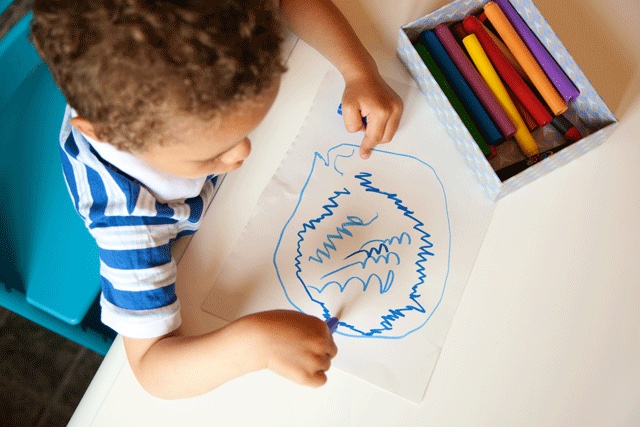Young children tend to love colors and making marks with pens, pencils, crayons, and markers. An easy home activity is setting up a “coloring or writing” space with markers, paper, tablets, and even old magazines. What your child does will depend on his developmental level and ability to hold markers. (You may want to talk with your child’s teacher or therapist about ways to adapt writing materials if fine-motor control is a concern.)
How can you support your child to scribble and draw and begin to gain early literacy skills? Consider ways to model writing. For example, you can make grocery lists with your child, naming what you plan to buy and writing the list. Your child will see that your marks on the list mean something. He may enjoy imitating you by making his own list. He can name food he would like you to buy and make scribbles or drawings to indicate the choice. He will learn over time that spoken words can be written and that lists start at the top of a page and go down. He may even notice that you read the lists from left to right.
You also might choose to “share writing.” That is, as you start your list, ask your child to name items she would like to buy. You can print the items on your list. This early print experience helps children learn that print or symbols and lists are ways to remember and communicate what is important. It also encourages your child to try and create messages.
When children begin to invent their own writing, it may look like a series of scribbles or marks. Encourage your child during this early phase and talk with her about what she is writing. (You can ask, “What do you want this to say” or “what do you want this to be?”) Don’t worry if the scribbles don’t look like letters or numbers. When children first begin to scribble, they may make up shapes and use circles, lines, and dots to symbolize writing. This is all part of early writing and gaining experience with holding different writing tools (fat crayons, pencil grips).
Children with developmental delays or who have difficulty with fine-motor control may spend more time at the early scribble stage. Admire this exploration, and if it makes sense, comment about what she is drawing or writing. If you have stamps and inkpads, add those to the writing area and see how your child uses these. Stamping is easier than using writing tools. She may use the stamps to create birthday cards or stories or simply enjoy the cause and effect of stamping and seeing what the stamp produces.
Remember that early literacy is a part of play and daily living and it’s an experience that all children should have. Children scribble before they draw, and they make lines and circles and draw funny shapes before they make pictures. They experiment with how they hold a marker, and they may start out holding it in a fist before they hold it between two or three fingers. Giving your child opportunities to pretend to write and to use writing materials as part of their play is an experience that prepares them for the future.

Susan Fowler
Dr. Susan Fowler is a retired professor of special education at the University of Illinois. Susan’s doctorate was in developmental and child psychology and she was one of the pioneers in early childhood special education and developmental disabilities. She also is a parent of a young man with exceptionalities.
Biography current as of 2022
IEL Resources
- Tip Sheet: The Power of the Pen: Drawing and Scribbling


